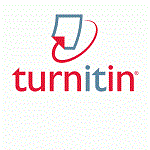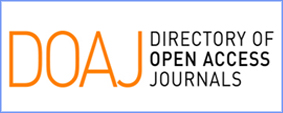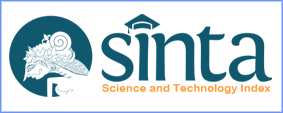Exploring Students Computational Thinking based on Self-Regulated Learning in the Solution of Linear Program Problem
Abstract
Keywords
Full Text:
PDFReferences
Barr, D., Harrison, J., & Conery, L. (2011). Computational Thinking: A Digital Age Skill for Everyone. Learning and Leading with Technology, 38(6), 20–23. Retrieved from http://quijote.biblio.iteso.mx/wardjan/proxy.aspx?url=https://search.ebscohost.com/login.aspx?direct=true&db=ehh&AN=59256559〈=es&site=eds-live%5Cnhttps://content.ebscohost.com/ContentServer.asp?T=P&P=AN&K=59256559&S=R&D=ehh&EbscoContent=dGJyMMTo50Sep6
Guzdial, M. (2008). Education Paving the way for computational thinking. Communications of the ACM, 51(8), 25. https://doi.org/10.1145/1378704.1378713
Jamil, H. M. (2017). Visual Computational Thinking Using Patch. ICWL, 10473, 208–214. https://doi.org/10.1007/978-3-319-66733-1
Latipah, E. (2010). Strategi Self Regulated Learning dan Prestasi Belajar : Jurnal Psikologi, 37(1), 110–129.
Maharani, S., Nusantara, T., As’ari, A. R., & Qohar, A. (2019). How The Students Computational Thinking Ability On Algebraic? International Journal of Scientific & Technology Research, 8(9).
Muis, K. R. (2008). Epistemic profiles and self-regulated learning: Examining relations in the context of mathematics problem solving. Contemporary Educational Psychology, 33(2), 177–208. https://doi.org/10.1016/j.cedpsych.2006.10.012
Noroozi, O., Järvelä, S., & Kirschner, P. A. (2019). Introduction paper special issue computers in human behavior multidisciplinary innovations and technologies for facilitation of self-regulated learning. Computers in Human Behavior. https://doi.org/10.1016/j.chb.2019.07.020
Orton, K., Weintrop, D., Beheshti, E., Horn, M., Jona, K., & Wilensky, U. (2016). Bringing Computational Thinking into High School Mathematics and Science Classrooms. Transforming Learning, Empowering Learners: The International Conference of the Learning Sciences (ICLS) 2016, Volume 2, 705–712.
Peters-Burton, E. E., Cleary, T. J., & Kitsantas, A. (2015). The development of computational thinking in the context of science and engineering practices: A self-regulated learning approach. Proceedings of the 12th International Conference on Cognition and Exploratory Learning in the Digital Age, CELDA 2015, (Celda), 257–261.
Rambally, G. (2017). Integrating Computational Thinking in Discrete Structures. In Emerging Research, Practice, and Policy on Computational Thinking, Educational Communications and Technology: Issues and Innovations (pp. 99–119). https://doi.org/10.1007/978-3-319-52691-1
Sanford, J. F., & Naidu, J. T. (2016). Computational Thinking Concepts for Grade School. Contemporary Issues in Education Research, 9(1), 23–32.
Schroeder, C. M., Scott, T. P., Tolson, H., Huang, T.-Y., & Lee, Y.-H. (2007). The challenge of altering elementary school teachers’ beliefs and practices regarding linguistic and cultural diversity in science instruction. Journal of Research in Science Teaching, 44(2), 1269–1291. https://doi.org/10.1002/tea
Whittle, R. J., Telford, A., & Benson, A. (2015). The ‘Perfect’ Senior (VCE) Secondary Physical Education Teacher: Student Perceptions of Teacher-related Factors that Influence Academic Performance. Australian Journal of Teacher Education, 40(40). https://doi.org/10.14221/ajte.2015v40n8.1
Wilensky, U., & Weintrop, D. (2016). Constructionist Approaches for Computational Thinking in Math and Science classrooms.
Zamnah, L. N. (2017). Hubungan Antara Self-Regulated Learning Dengan Kemampuan Pemecahan Masalah Matematis Pada Mata Pelajaran Matematika Kelas Viii Smp Negeri 3 Cipaku Tahun Pelajaran 2011/2012. Jurnal Teori Dan Riset Matematika (TEOREMA), 1(2), 31. https://doi.org/10.25157/.v1i2.549
Zheng, J., Xing, W., Zhu, G., Chen, G., Zhao, H., & Xie, C. (2020). Profiling self-regulation behaviors in STEM learning of engineering design. Computers & Education, 143(August 2019), 103669. https://doi.org/10.1016/j.compedu.2019.103669
Article Metrics
Abstract has been read : 2519 timesPDF file viewed/downloaded: 0 times
DOI: http://doi.org/10.25273/jipm.v8i1.4871
Refbacks
- There are currently no refbacks.
Copyright (c) 2019 JIPM (Jurnal Ilmiah Pendidikan Matematika)

This work is licensed under a Creative Commons Attribution-ShareAlike 4.0 International License.
View JIPM Stats
JIPM indexed by:
Copyright of JIPM (Jurnal Ilmiah Pendidikan Matematika) ISSN 2502-1745 (Online) and ISSN 2301-7929 (Print)













